Hamal, or Alpha Arietis, is the brightest star in the zodiacal constellation of Aries, the Ram. It is the 50th brightest star in the night sky and it also may host an exoplanet.
Key Facts & Summary
- Hamal is an evolved giant star of stellar classification K2 III Ca-1. It is located at an estimated 65.8 light-years / 20.2 parsecs away from the Sun.
- Hamal has an apparent magnitude of 2.00 and an absolute magnitude estimated at around +0.47.
- The star is suspected of being a slightly variable type of star, with an amplitude of 0.06 magnitude.
- Hamal has exhausted the supply of hydrogen at its core and is now on the red giant branch. The Ca-1 portion of the classification indicates that it shows weaker than normal lines of calcium in its spectrum.
- The star has served since 1943 as one of the stable anchor points by which other stars are classified.
- Hamal has average surface temperatures of around 4.480 K, much cooler than our sun, however, this contributes to its orange-hued glow, typical of a K-type star.
- Hamal is 91 times brighter than our sun and has surface temperatures of around 2.57 cgs.
- Hamal has 50% more mass than our sun, with an estimated 1.5 solar masses.
- Hamal has around 14.9 solar radii, thus it is almost 15 times larger in diameter than our sun.
- Based on the abundance of elements, with the exception of hydrogen and helium, Hamal has metallicity is only around half that of the suns.
- Though Hamal has a huge bulk, 15 times greater than the sun’s, it rotates faster. Hamal has an estimated rotational velocity of around 3.44 km / 2.1 mi per second.
- In the year 2011, a planet was suspected to orbit around Hamal. It was designated Hamal b.
- Hamal b hasn’t yet been directly observed, but studies suggest it is bigger than Jupiter.
Since Hamal is situated in the celestial head of the ram, its traditional name had to correspond to this. Hamal is derived from the Arabic phrase “ras-al-hamal” which translates to “head of the ram.”
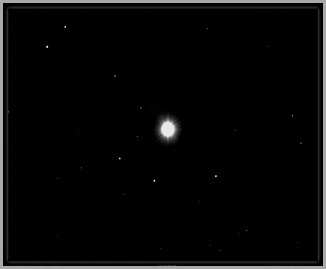
This is taken from the original Arabic name of the constellation as a whole, Al Hamal – the ram. Between 2.000 and 100 B.C.E., the apparent path of the Sun, through the sky as seen from Earth, placed Hamal in Aries at the point of the northern vernal equinox – which marked in the northern hemisphere the advent of spring.
Formation
Currently, it is unknown if Hamal is associated with any stellar group of moving stars. What is known is that Hamal formed at around 3.4 billion years ago from a molecular cloud of dust and gas. Gravity pulled together the swirling dust and gas and formed the brightest star of the zodiacal constellation of Aries, Hamal.
Distance, Size, and Mass
Hamal is located at an estimated 65.8 light-years / 20.2 parsecs away from the Sun. It is the 50th brightest star in the night sky, visible to the naked eye.
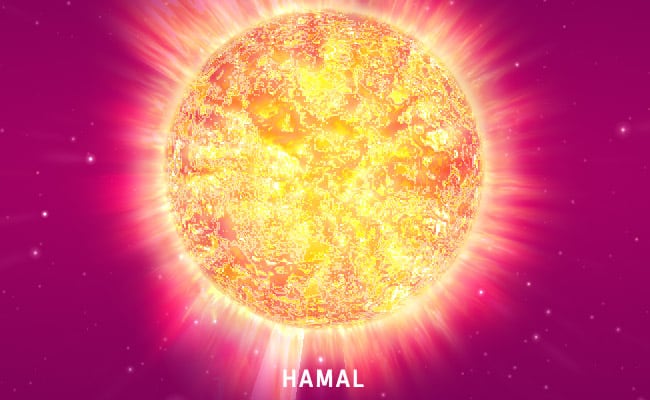
Hamal has 50% more mass than our sun, with an estimated 1.5 solar masses, and around 14.9 solar radii, thus it is almost 15 times larger in diameter than our sun.
Other Characteristics
Hamal is an evolved giant star of stellar classification K2 III Ca-1 currently on the red giant branch. It appears orange-red and has an apparent magnitude of +2.00, and an absolute magnitude estimated at around +0.47.
There are also slight variations in its brightness, with observed variations in luminosity of 0.06 magnitudes. It is 91 times brighter than our sun, yet cooler, with surface temperatures estimated at 4.480 K.
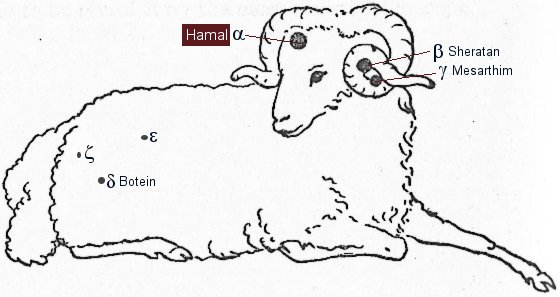
When it comes to its composition, the star has exhausted its hydrogen supplies and it displays an abundance of elements of only half that of the sun.
The Ca-1 portion of Hamal’s classification indicates that it shows weaker than normal lines of calcium in its spectrum as well. Thus, the star has served as early as 1943 as one of the stable anchor points by which other stars are classified. Hamal has an estimated rotational velocity of around 3.44 km / 2.1 mi per second, faster than our sun, and its surface gravity is around 2.57 cgs. In 2011 a potential planet was speculated to exist near Hamal.
Planetary System
Through the radial velocity method, a team from Bohynusan Optical Astronomy Observatory in Korea estimated that a planet is present in Hamal’s vicinity.
It is currently unknown if it truly exists, however, estimations suggest that this hypothetical planet would be 1.8 times more massive than Jupiter.
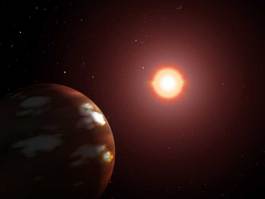
Hamal b, as designated, would complete an orbit around Hamal, once every 380 days with an eccentric orbit of around 0.25 – which would make its closest approach at around 0.9 AU, and its farthest distance from Hamal at 1.5 AU. By comparison, Hamal has a radius of 0.07 AU.
Location
Hamal is located in the zodiacal constellation of Aries, the ram. It marks the ram’s head along with Sheratan and Mesarthim.
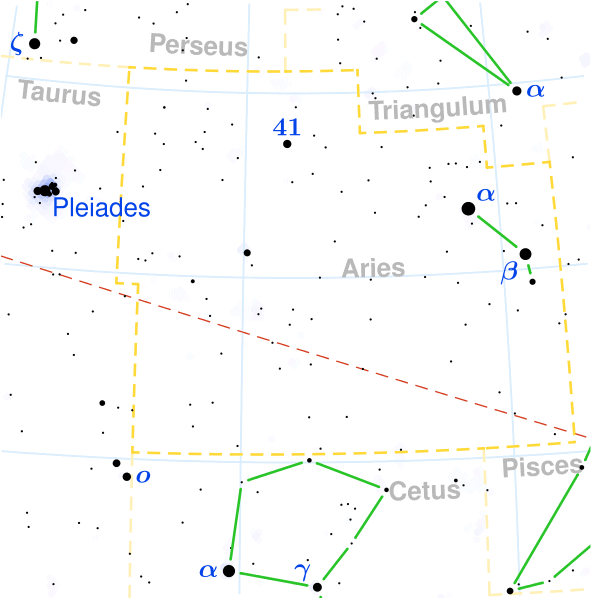
From mid-northern latitudes, Hamal lights up the eastern sky on autumn evenings, in the southern sky on winter evenings, and sits in the west on early spring evenings. Thus the best time to observe stars and other deep-sky objects in the constellation of Aries is in spring and in winter.
The Future
Hamal has used up its hydrogen supplies and has thus evolved onto the red giant branch. It will shrink and get hotter while its outer layers puff outward. It will expand several times its current size.
Did you know?
- Though the vernal equinox has moved from the constellation of Aries to Pisces, due to the precession of the equinoxes, Hamal has remained in our consciousness as one of the most important stars.
- Due to the fact that the vernal equinox used to be associated with Aries, most astrology columns in modern newspapers, still begin the zodiac reading with Aries, as a symbol of its great importance.
- Currently, Hamal’s declination is almost exactly equal to the latitude of the Tropic of Cancer, thus the star can be used to find the position of the imaginary line when the Sun is not nearby.
- A lead ship of a class of two destroyer tenders was most likely named after Hamal. It is the US ship USS Hamul (AD-20).
Sources:
Image source:
- https://i2.wp.com/thriveonnews.com/wp-content/uploads/2012/10/hamal.jpg?resize=326%2C269
- https://osr.org/wp-content/uploads/2016/04/hamal-star.jpg
- https://www.constellationsofwords.com/images/stars/hamal.JPG
- https://nstrat19-igs-aries.weebly.com/uploads/4/0/1/0/40101007/613483327.jpg?267
- https://upload.wikimedia.org/wikipedia/commons/thumb/f/f8/Aries_constellation_map.svg/592px-Aries_constellation_map.svg.png
